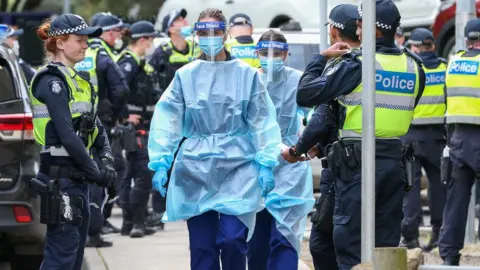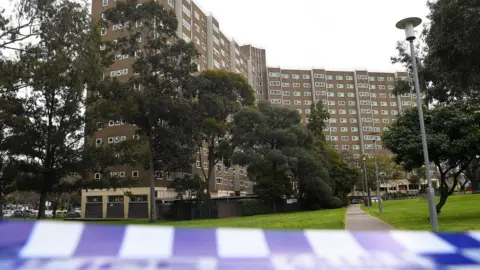Coronavirus: Australia to close Victoria-New South Wales border
 Getty Images
Getty ImagesThe border between Australia's two most populous states, Victoria and New South Wales (NSW), is to close after a spike in Covid-19 cases in Melbourne.
The outbreak in Victoria's capital has seen hundreds of cases in the past two weeks - more than 95% of new Australian infections.
Until now, the two states had maintained open borders even when others had shut them.
The closure, beginning on Wednesday, will restrict travel to permit holders.
Victoria's Premier Daniel Andrews said it was a joint decision with Prime Minister Scott Morrison and NSW Premier Gladys Berejiklian.
"This is one of those precautionary measures - it is one of those things that I think will help us in broader terms contain the spread of the virus," Mr Andrews told reporters on Monday.
He gave no indication of when the border might re-open. Flying between Sydney and Melbourne - the state capitals - is ordinarily among the world's busiest routes.
What's caused this?
The three leaders had previously said border closures weren't necessary, but the surge in locally spread cases has caused alarm.
Previously, most cases had involved returning overseas travellers in quarantine - now over 80% are coming from within the community.
"This is unprecedented in Australia. We have not seen anything like this," said Ms Berejiklian.
Victoria has traced many recent infections to quarantine hotels where security guards reportedly broke the rules by interacting with guests and each other.
In early June, when no cases were reported on two days, state officials had hoped they were nearing having the virus contained.
But Victoria recorded 127 new infections on Monday - its highest daily increase since the pandemic began.
What does the border closure mean?
Mr Andrews said those who had "unavoidable travel" could apply for permits to cross the border, including for work.
NSW authorities will be in charge of guarding border crossings, and flights will be cancelled.
Mr Andrews acknowledged the decision would be difficult for many people but said it was necessary given "the significant challenges we face in containing this virus".


It's the first time in a century that the border between New South Wales and Victoria is being closed.
The closure shows the level of anxiety and concern among leaders and health authorities about Covid-19 spreading beyond Victoria's borders and into NSW, the most populous state.
Both Ms Berejiklian and Mr Morrison have previously played down the possibility of such a closure, but Victoria now finds itself in a very critical situation.
There'll be the inevitable economic and social impacts of course but the logistics of closing are also a big challenge. There are about 50 border crossings between the two states with some towns sharing the border.
Those who cross over regularly have been told they'll be able to get permits but can be sure to expect delays.
With school holidays starting here, many families who have been looking forward to finally having a vacation away will now have to cancel their trips.

How else is Australia responding?
The outbreak is threatening Australia's relative success so far in suppressing the virus.
The military and other states are helping Victorian authorities carry out a testing blitz. At least 20,000 people are being tested per day.
On Saturday, Victoria enacted a "hard lockdown" on nine housing estate tower blocks in Melbourne - confining 3,000 people to their homes - after a cluster of cases were found.
Many residents have expressed anger over the sudden implementation of the lockdown. Critics say the policy - which involves police patrols inside the building - targets a racially diverse and already marginalised community.
Residents in at least 36 "hotspot" suburbs were put into a separate lockdown last week. Unlike those in the tower blocks, they can leave home for work, exercise, care and grocery shopping.
 EPA
EPAThe virus has been dramatically slowed in other states, which are largely now free of lockdown measures.
Australia had aimed to be completely out of lockdown by the end of July - but there are now calls for this national goal to be delayed.
Despite the latest spike, case numbers remain low compared to many nations. Since January, Australia has recorded 106 deaths and around 8,500 cases.
